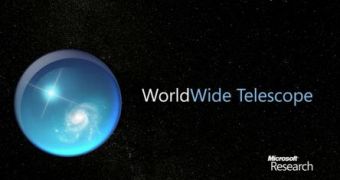Microsoft has made available a new release of its application for desktop astronomers, a move which is synonymous with a new stage of the development process for the WorldWide Telescope web client. Users will now be able to notice that the Redmond-based company has scrapped the Technical Preview label that accompanied the web-based app since its introduction. As of August 2009, Microsoft’s WorldWide Telescope web client has entered the Beta development phase. According to the software giant, there is now a near parity between the web and Windows clients.
WorldWide Telescope Aphelion was introduced on August 17th, a new milestone for the work done by the External Research division of Microsoft Research. The Aphelion release brings to desktops around the world what Microsoft estimates to be hundreds of terabytes of images from a variety of sources, including NASA’s Hubble Space Telescope, Chandra X-ray Observatory Center, and Spitzer Space Telescope.
“We have a significant number of rich science features that are going to be available to researchers,” revealed Jonathan Fay, principal architect for the WorldWide Telescope project (via LiveSide), “and we have a completely reworked data set for our beautiful, 3-D universe mode.”
Microsoft continues to emphasize that WorldWide Telescope is within the reach of both amateur astronomers, as well as scientists. However, the company’s strategy is to first of all democratize astronomy data, and make it available to the whole world as opposite to just a closed circle of astronomers.
“But now,” Fay added, “You’ll be able to take science-quality data and immediately visualize it. It could be used for scientific research on unpublished data. People can load files from their local machines, from research databases and catalogs, and see them in the sky. And you can use keywords like “Hubble” or “Chandra” and search for categories of objects and the imagery available for those areas. We’re enabling access to this huge database of scientific information. You potentially can go all the way to the raw data. It’s enabling research-quality data access.”
More importantly, the user experience in WorldWide Telescope has also evolved. Microsoft emphasized that with the Aphelion milestone, desktop astronomers would be able to enjoy a 3-D Universe. Essentially, WorldWide Telescope Aphelion allows end users to explore the universe in three dimensions, to orbit around clusters and to fly into galaxies.
“We’ve done a lot of data processing with Johns Hopkins University, the Sloan Digital Sky Survey, and the Adler Planetarium to create this view of the universe based upon data,” Fay explained. “We can actually fly to various clusters and see all these individual galaxies. Up to a certain brightness magnitude, this is a fairly complete model, and each of these galaxies is put into its proper location. The galaxy types, their colors and patterns, are very close representatives of the actual images.”
WorldWide Telescope Aphelion is available for download here.

 14 DAY TRIAL //
14 DAY TRIAL //